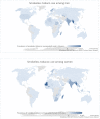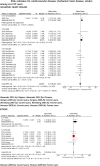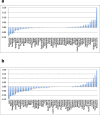Global burden of disease due to smokeless tobacco consumption in adults: an updated analysis of data from 127 countries
- PMID: 32782007
- PMCID: PMC7422596
- DOI: 10.1186/s12916-020-01677-9
Global burden of disease due to smokeless tobacco consumption in adults: an updated analysis of data from 127 countries
Abstract
Background: Smokeless tobacco (ST) is consumed by more than 300 million people worldwide. The distribution, determinants and health risks of ST differ from that of smoking; hence, there is a need to highlight its distinct health impact. We present the latest estimates of the global burden of disease due to ST use.
Methods: The ST-related disease burden was estimated for all countries reporting its use among adults. Using systematic searches, we first identified country-specific prevalence of ST use in men and women. We then revised our previously published disease risk estimates for oral, pharyngeal and oesophageal cancers and cardiovascular diseases by updating our systematic reviews and meta-analyses of observational studies. The updated country-specific prevalence of ST and disease risk estimates, including data up to 2019, allowed us to revise the population attributable fraction (PAF) for ST for each country. Finally, we estimated the disease burden attributable to ST for each country as a proportion of the DALYs lost and deaths reported in the 2017 Global Burden of Disease study.
Results: ST use in adults was reported in 127 countries; the highest rates of consumption were in South and Southeast Asia. The risk estimates for cancers were also highest in this region. In 2017, at least 2.5 million DALYs and 90,791 lives were lost across the globe due to oral, pharyngeal and oesophageal cancers that can be attributed to ST. Based on risk estimates obtained from the INTERHEART study, over 6 million DALYs and 258,006 lives were lost from ischaemic heart disease that can be attributed to ST. Three-quarters of the ST-related disease burden was among men. Geographically, > 85% of the ST-related burden was in South and Southeast Asia, India accounting for 70%, Pakistan for 7% and Bangladesh for 5% DALYs lost.
Conclusions: ST is used across the globe and poses a major public health threat predominantly in South and Southeast Asia. While our disease risk estimates are based on a limited evidence of modest quality, the likely ST-related disease burden is substantial. In high-burden countries, ST use needs to be regulated through comprehensive implementation of the World Health Organization Framework Convention for Tobacco Control.
Keywords: Cancer; Chewing; Ischaemic heart disease; Mouth; Oesophagus; Oral; Pharynx; Smokeless tobacco.
Conflict of interest statement
None declared
Figures




References
-
- National Cancer Institute and Centers for Disease Control and Prevention. Smokeless tobacco and public health: a global perspective. U.S. Department of Health and Human Services, Centers for Disease Control and Prevention and National Institutes of Health, National Cancer Institute; 2014. Bethesda, MD NIH Publication No 14–-7983. https://cancercontrol.cancer.gov/brp/tcrb/global-perspective/SmokelessTo....
-
- Moghbel N, Ryu B, Cabot PJ, Ratsch A, Steadman KJ. In vitro cytotoxicity of Nicotiana gossei leaves, used in the Australian Aboriginal smokeless tobacco known as pituri or mingkulpa. Toxicol Lett. 2016;254:45–51. - PubMed
-
- Maki J. The incentives created by a harm reduction approach to smoking cessation: snus and smoking in Sweden and Finland. Int J Drug Policy. 2015;26:569–574. - PubMed
-
- Palipudi K, Rizwan SA, Sinha DN, Andes LJ, Amarchand R, Krishnan A, et al. Prevalence and sociodemographic determinants of tobacco use in four countries of the World Health Organization: South-East Asia region: findings from the Global Adult Tobacco Survey. Indian J Cancer. 2014;51(Suppl 1):S24–S32. - PubMed
-
- IARC Working Group on the Evaluation of Carcinogenic Risks to Humans, World Health Organization, International Agency for Research on Cancer. Smokeless Tobacco and Some Tobacco-specific N-nitrosamines. Lyon: World Health Organization; 2007. https://monographs.iarc.fr/wp-content/uploads/2018/06/mono89.pdf.
Publication types
MeSH terms
Grants and funding
LinkOut - more resources
Full Text Sources
Medical

